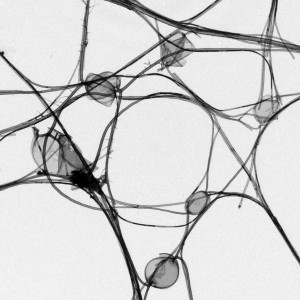Marine
MSS Photograph to be Displayed in Great North Museum
January 16, 2012 by sfraser No Comments | Category Marine Directorate general, Marine Directorate Science
During 2012 the British Phycological Society, a society that promotes the study of phytoplankton and algae in UK waters, will celebrate its Golden Jubilee. One of the events planned to mark this occasion is an exhibition of short-listed photographs from the Hilda Canter-Lund photographic competition, which will take place in the Great North Museum in Newcastle.
A photograph taken by Eileen Bresnan, one of our scientists based at the Marine Laboratory in Aberdeen is to be included in the display. The photograph entitled ‘Chaetoceros chaos’ was taken using a transmission electron microscope while examining phytoplankton from a water sample taken at one of the MSS ecosystem monitoring sites at Loch Ewe on the West Coast.
Chaetoceros is a diatom, which is a type of phytoplankton that has an outer case of silica. It forms long chains of small cells in the water column and has long hair-like structures projecting outwards which aid buoyancy in the water. The protocols used to prepare this sample for analysis resulted in the swirling pattern seen in the photograph. To give an idea of scale the diameter of the entire photograph is equivalent to approximately half the width of a human hair.
MSS has an active group of scientists who investigate the diversity and ecology of phytoplankton in Scottish waters. Most phytoplankton are single-celled algae, the majority of which live suspended in the water column. They are so small that a high powered microscope is required to observe the species that occur in Scottish waters. Phytoplankton play a critical role in the marine food web. Like garden plants they use energy from the sun to convert nutrients into fuel to grow and reproduce. They form the main food source for zooplankton (small animals). Zooplankton in turn form the main food source for fish larvae.
Phytoplankton are the focus of interest for many researchers and policy makers as the composition and abundance of the phytoplankton community can be influenced by a variety of environmental factors such as climate change or nutrient-enhancement (eutrophication). Some phytoplankton species can negatively affect the marine ecosystem as they can produce biotoxins that result in closures of shellfish harvesting areas. Some species can kill animals on the sea bed or, in some instances, farmed fish. When these phytoplankton species increase in abundance they are referred to as a harmful algal bloom.
Information on marine ecosystems (http://www.scotland.gov.uk/Topics/marine/marine-environment/ecosystems) and the MSS ecosystem monitoring programme can be found on the SG website.
Tags: biotoxins, climate change, eutrophication, phytoplankton



Leave a comment